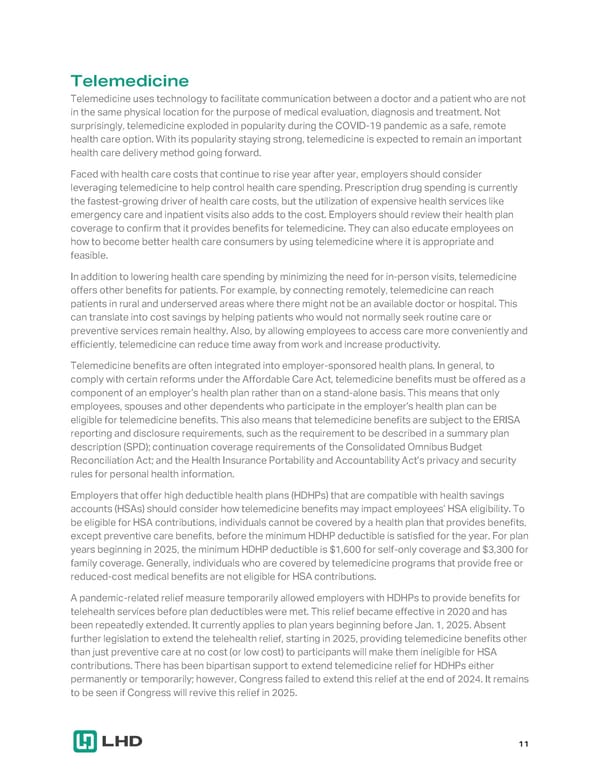Telemedicine Telemedicine uses technology to facilitate communication between a doctor and a patient who are not in the same physical location for the purpose of medical evaluation, diagnosis and treatment. Not surprisingly, telemedicine exploded in popularity during the COVID-19 pandemic as a safe, remote health care option. With its popularity staying strong, telemedicine is expected to remain an important health care delivery method going forward. Faced with health care costs that continue to rise year after year, employers should consider leveraging telemedicine to help control health care spending. Prescription drug spending is currently the fastest-growing driver of health care costs, but the utilization of expensive health services like emergency care and inpatient visits also adds to the cost. Employers should review their health plan coverage to confirm that it provides benefits for telemedicine. They can also educate employees on how to become better health care consumers by using telemedicine where it is appropriate and feasible. In addition to lowering health care spending by minimizing the need for in-person visits, telemedicine offers other benefits for patients. For example, by connecting remotely, telemedicine can reach patients in rural and underserved areas where there might not be an available doctor or hospital. This can translate into cost savings by helping patients who would not normally seek routine care or preventive services remain healthy. Also, by allowing employees to access care more conveniently and efficiently, telemedicine can reduce time away from work and increase productivity. Telemedicine benefits are often integrated into employer-sponsored health plans. In general, to comply with certain reforms under the Affordable Care Act, telemedicine benefits must be offered as a component of an employer’s health plan rather than on a stand-alone basis. This means that only employees, spouses and other dependents who participate in the employer’s health plan can be eligible for telemedicine benefits. This also means that telemedicine benefits are subject to the ERISA reporting and disclosure requirements, such as the requirement to be described in a summary plan description (SPD); continuation coverage requirements of the Consolidated Omnibus Budget Reconciliation Act; and the Health Insurance Portability and Accountability Act’s privacy and security rules for personal health information. Employers that offer high deductible health plans (HDHPs) that are compatible with health savings accounts (HSAs) should consider how telemedicine benefits may impact employees’ HSA eligibility. To be eligible for HSA contributions, individuals cannot be covered by a health plan that provides benefits, except preventive care benefits, before the minimum HDHP deductible is satisfied for the year. For plan years beginning in 2025, the minimum HDHP deductible is $1,600 for self-only coverage and $3,300 for family coverage. Generally, individuals who are covered by telemedicine programs that provide free or reduced-cost medical benefits are not eligible for HSA contributions. A pandemic-related relief measure temporarily allowed employers with HDHPs to provide benefits for telehealth services before plan deductibles were met. This relief became effective in 2020 and has been repeatedly extended. It currently applies to plan years beginning before Jan. 1, 2025. Absent further legislation to extend the telehealth relief, starting in 2025, providing telemedicine benefits other than just preventive care at no cost (or low cost) to participants will make them ineligible for HSA contributions. There has been bipartisan support to extend telemedicine relief for HDHPs either permanently or temporarily; however, Congress failed to extend this relief at the end of 2024. It remains to be seen if Congress will revive this relief in 2025. 11
 2025 Employee Benefits Market Outlook Page 10 Page 12
2025 Employee Benefits Market Outlook Page 10 Page 12